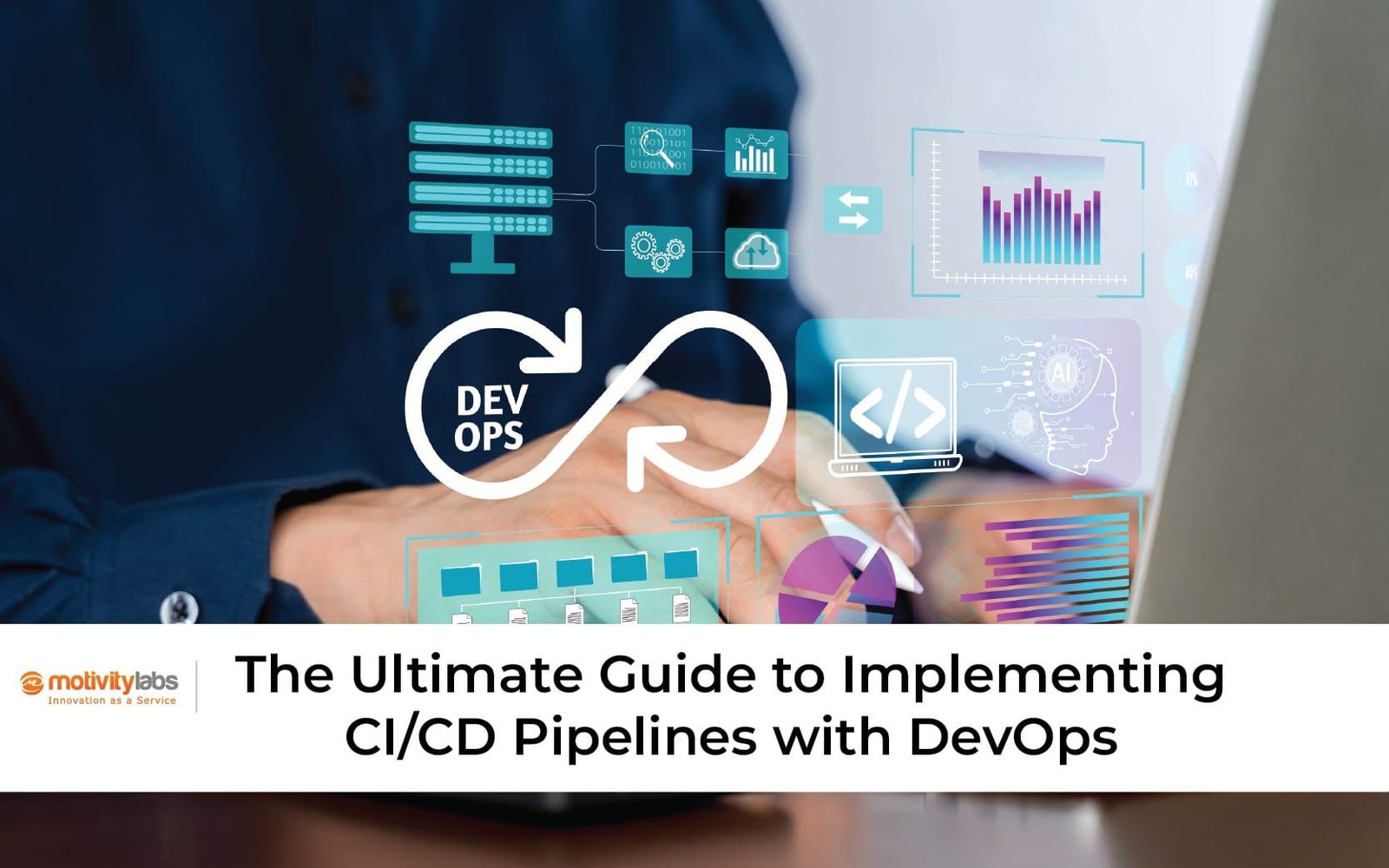Table of Contents
Speed, quality, and reliability are the new cornerstones of successful software delivery. But achieving all three at once? That is where the real challenge begins. Enter CI/CD pipelines (Continuous Integration and Continuous Delivery/Deployment), tools, and practices designed to automate and streamline the path from code to production. When combined with the collaborative power of DevOps, CI/CD becomes more than just a process. It becomes a strategic enabler of innovation.
If you are aiming to build faster, deploy smarter, and minimize risk, this blog is your blueprint for implementing CI/CD pipelines with DevOps at the core.
First, What is CI/CD?
Let us break it down in plain terms:
- Continuous integration is the practice of regularly merging code changes from multiple developers into a central repository. Every check-in is automatically tested, ensuring that issues are spotted early.
- Continuous delivery ensures that code changes are automatically prepared for a production release. It stops short of pushing the code live, but everything is in place.
- A step further, continuous deployment goes all the way, automatically deploying every successful build to production without human intervention.
This end-to-end automation means teams can release better software faster and more often. That is not just efficiency. It is a game-changer.
Why CI/CD Matters in DevOps
DevOps is all about breaking down silos between development and operations. It is a culture, a set of practices, and tools that bring teams together to deliver software with agility. Now, enter CI/CD. These pipelines are the technical backbone that turns DevOps theory into real-world velocity.
Here is why they matter:
- Faster releases: From code commit to deployment in hours instead of weeks.
- Fewer bugs: Continuous testing catches issues early.
- Happier teams: Less firefighting, more innovating.
- Greater customer satisfaction: Users get new features and fixes faster.
CI/CD is not just a cool idea. It is the actual engine that powers DevOps’ success.
The Building Blocks of a CI/CD Pipeline
Setting up a pipeline can feel overwhelming at first. However, it becomes second nature once you understand the components:
Let us break it down in plain terms:
- Continuous integration is the practice of regularly merging code changes from multiple developers into a central repository. Every check-in is automatically tested, ensuring that issues are spotted early.
- Continuous delivery ensures that code changes are automatically prepared for a production release. It stops short of pushing the code live, but everything is in place.
- A step further, continuous deployment goes all the way, automatically deploying every successful build to production without human intervention.
This end-to-end automation means teams can release better software faster and more often. That is not just efficiency. It is a game-changer.
1. Source Code Repository
This is your single source of truth. Git is the go-to, whether you are using GitHub, GitLab, or Bitbucket. Developers commit code here, triggering the pipeline.
2. Build Server (CI Server)
The CI server automatically builds and integrates the code when changes are committed. Popular tools include Jenkins, CircleCI, Travis CI, and GitLab CI.
3. Automated Testing
Tests run right after a build to catch bugs early. These include unit tests, integration tests, and UI tests. The more automation here, the better.
4. Artifact Repository
Once the code is built and tested, it is packaged into deployable units (like Docker images or .jar files). These are stored in artifact repositories like JFrog Artifactory or Nexus.
5. Deployment Automation
Now comes delivery/deployment. Tools like Spinnaker, Argo CD, or Kubernetes-native methods roll out your changes to staging or production environments.
6. Monitoring and Feedback
DevOps does not end at deployment. Tools like Prometheus, Grafana, Datadog, or Splunk provide real-time visibility and alerting.
Step-by-Step: Implementing a CI/CD Pipeline
Here is a practical approach to getting started:
Step 1: Define Goals
Start by answering:
- What are you trying to deliver?
- How often do you want to deploy?
- What’s your tolerance for failure?
Clear goals help design the correct pipeline for your needs.
Step 2: Version Control is a Must
Ensure all your code, scripts, and configuration files are in a Git repository. Embrace GitOps principles, where Git is the source of truth for everything.
Step 3: Automate the Build Process
Set up your CI server (e.g., Jenkins or GitHub Actions) to trigger on every commit. Define build jobs in a configuration file (like Jenkinsfile or .yml) and make it repeatable.
Step 4: Integrate Automated Testing
Start with unit tests and gradually layer in integration and functional testing. Use test coverage tools to ensure quality. The guiding principle here is early detection.
Step 5: Build Artifacts and Store Them
Use tools like Maven or Docker to package your code. Store these builds in a secure, versioned repository. This ensures traceability and rollback ability.
Step 6: Deploy Continuously
Set up automated deployment to staging environments first. Once confidence builds, push to production via manual approval or continuous deployment.
Pro tip: Use blue-green deployments or canary releases to minimize risk.
Step 7: Monitor and Learn
Implement monitoring and log aggregation. Set up alerts, dashboards, and metrics. More importantly, feeds insights back into your development process.
Best Practices to Supercharge Your CI/CD Pipeline
To make your pipeline truly DevOps-ready, keep these best practices in mind:
- Keep pipelines fast: Long builds kill productivity. Use caching and parallelism to speed things up.
- Fail loudly and early: Do not let errors slip into later stages. Let failures stop the pipeline.
- Use feature flags: Deploy code without exposing it to users right away.
- Secure everything: Scan for vulnerabilities and secrets at every stage.
- Practice rollback: Always be ready to revert a deployment.
Document and share: A pipeline no one understands is a pipeline no one can trust.
Tools of the Trade: A Quick Stack
Here is a sample stack that brings CI/CD to life:
| Function | Tools |
| Version Control | Git, GitHub, GitLab |
| CI Server | Jenkins, GitHub Actions, CircleCI |
| Testing | JUnit, Selenium, Postman |
| Artifact Repository | Nexus, JFrog Artifactory |
| Deployment | Docker, Kubernetes, Helm, Argo CD |
| Monitoring | Prometheus, Grafana, New Relic |
Real Talk: Common Pitfalls to Avoid
CI/CD is not just a button you press. It is a mindset. Here are some traps teams fall into:
- Skipping tests to go faster
- Overcomplicating pipelines without clear benefits
- Not involving ops and QA early enough
- Treating CI/CD as an afterthought, not part of product design
The best way to avoid these? Start small. Iterate. Learn.
CI/CD is Your DevOps Superpower
Implementing CI/CD pipelines is not about chasing trends. It is about making software delivery smarter, faster, and safer. By integrating development, testing, and deployment into a seamless flow, CI/CD unlocks the full potential of DevOps.
Whether you are a startup pushing out MVPs or an enterprise managing hundreds of microservices, CI/CD offers the structure you need. It helps teams move with greater confidence, speed, and agility.
When you are ready to take your DevOps game to the next level, Motivity Labs has your back. With deep expertise in automation, cloud infrastructure, and agile transformation, Motivity Labs helps organizations like yours build robust, scalable, and efficient CI/CD pipelines that deliver authentic results.
Let’s build better, faster, together.



